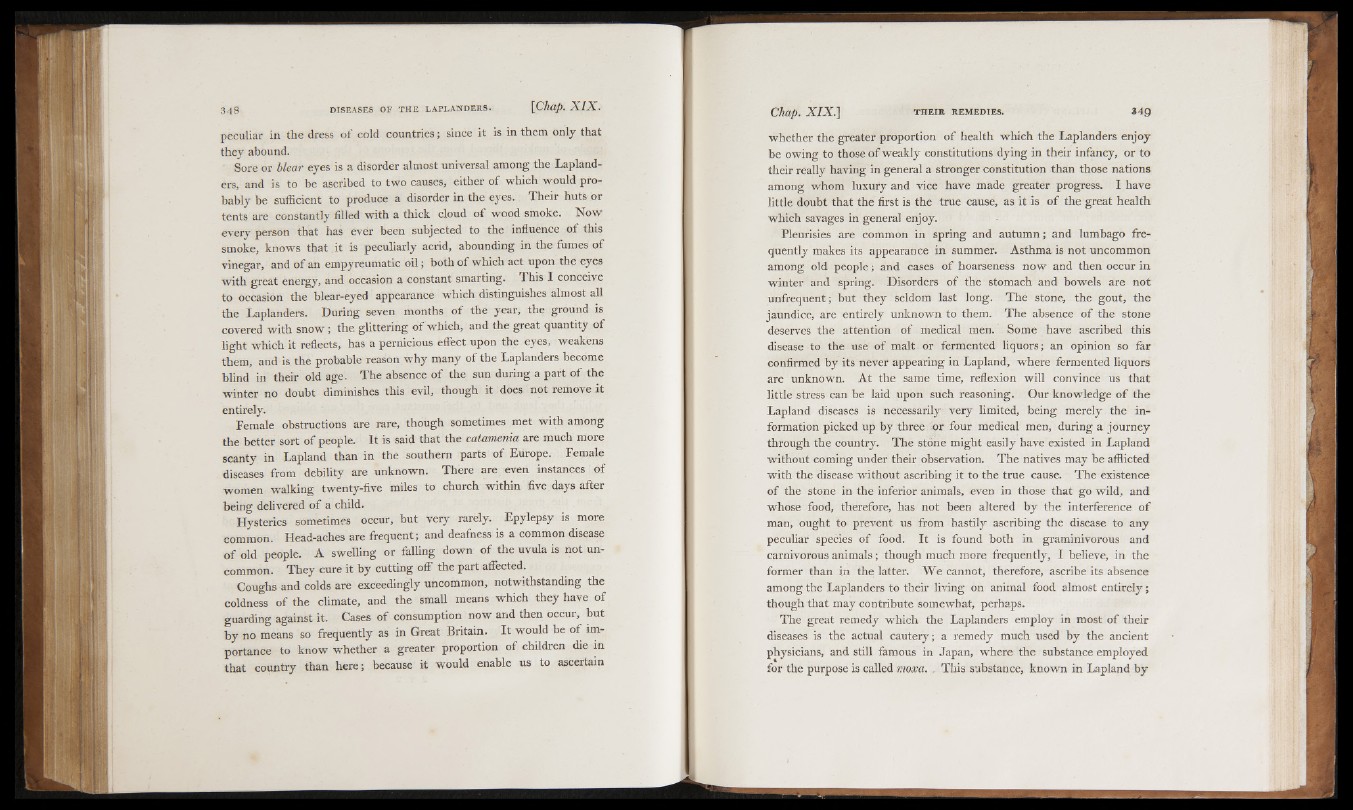
peculiar in the dress o f cold countries; since it is in them only that
they abound.
Sore or blear eyes is a disorder almost universal among the Laplanders,
and is to be ascribed to two causes, either o f which would probably
be sufficient to produce a disorder in the eyes. Their huts or
tents are constantly filled with a thick cloud o f wood smoke. N ow
every person that has ever been subjected to the influence o f this
smoke, knows that it is peculiarly acrid, abounding in the fumes o f
vinegar, and o f an empyreumatic o i l; both o f which act upon the eyes
with great energy, and occasion a constant smarting. This I conceive
to occasion the blear-eyed appearance which distinguishes almost all
the Laplanders. During seven months o f the year, the ground is
covered with snow ; the glittering o f which, and the great quantity o f
light which it reflects, has a pernicious effect upon the eyes, weakens
them, and is the probable reason why many o f the Laplanders become
blind in their old age. The absence o f the sun during a part o f the
winter no doubt diminishes this evil, though it does not remove it
entirely.
Female obstructions are rare, though sometimes met with among
the better sort o f people. I t is said that the catamenia are much more
scanty in Lapland than in the southern parts o f Europe. Female
diseases from debility are unknown. There are even instances of
women walking twenty-five miles to church within five days after
being delivered o f a child.
Hysterics sometimes occur, but very rarely. Epylepsy is more
common. Head-aches are frequent; and deafness is a common disease
o f old people. A swelling or falling down o f the uvula is not uncommon.
T he y cure it b y cutting off the part affected.
Coughs and colds are exceedingly uncommon, notwithstanding the
coldness o f the climate, and the small means which they have of
guarding against it. Cases o f consumption now and then occur, but
b y no means so frequently as in Great Britain. I t would be o f importance
to know whether a greater proportion o f children die in
that country than here; because it would enable us to ascertain
whether the greater proportion o f health which the Laplanders enjoy
be owing to those o f weakly constitutions dying in their infancy, or to
their really having in general a stronger constitution than those nations
among whom luxury and vice have made greater progress. I have
little doubt that the first is the true cause, as it is o f the great health
which savages in general enjoy.
Pleurisies are common in spring and autumn; and lumbago frequently
makes its appearance in summer. Asthma is not uncommon
among old people; and cases o f hoarseness now and then occur in
winter and spring. Disorders o f the stomach and bowels are not
unfrequent; but they seldom last long. The stone, the gout, the
jaundice, are entirely unknown to them. The absence o f the stone
deserves the attention o f medical men. Some have ascribed this
disease to the use of malt or fermented liquors; an opinion so far
confirmed by its never appearing in Lapland, where fermented liquors
are unknown. A t the same time, reflexion will convince us that
little stress can be laid upon such reasoning. Our knowledge o f the
Lapland diseases is necessarily very limited, being merely the information
picked up b y three or four medical men, during a journey
through the country. The stone might easily have existed in Lapland
without coming under their observation. The natives may be afflicted
with the disease without ascribing it to the true cause. The existence
o f the stone in the inferior animals, even in those that go wild, and
whose food, therefore, has not been altered by the interference o f
man, ought to prevent us from hastily ascribing the disease to any
peculiar species o f food. I t is found both in graminivorous and
carnivorous animals; though much more frequently, I believe, in the
former than in the latter. W e cannot, therefore, ascribe its absence
among the Laplanders to their living on animal food almost entirely;
though that may contribute somewhat, perhaps.
The great remedy which the Laplanders employ in most o f their
diseases is the actual cautery; a remedy much used b y the ancient
physicians, and still famous in Japan, where the substance employed
for the purpose is called noxa. . This substance, known in Lapland b y